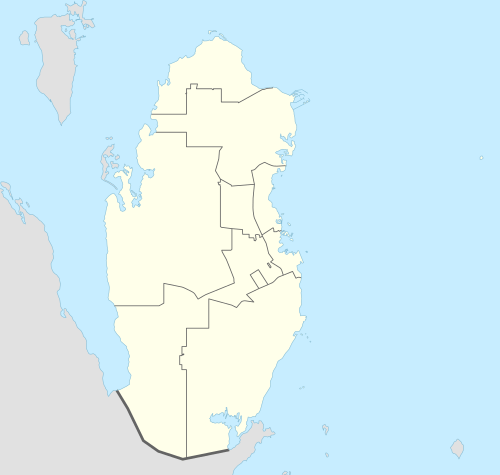Al Khor Island
| Jazirat bin Ghanim | |
 Shown within Qatar | |
| Alternate name |
Khor Ile-Sud Purple Island |
|---|---|
| Location | Northeast Qatar |
| Coordinates | 25°41′34″N 51°32′56″E / 25.69278°N 51.54889°ECoordinates: 25°41′34″N 51°32′56″E / 25.69278°N 51.54889°E |
| Type | Settlement |
| History | |
| Periods |
Neolithic period Bronze Age |
| Cultures |
Dilmun Kassites |
| Site notes | |
| Excavation dates | 1976 |
| Archaeologists | Jacques Tixier |

Al Khor Island, also known as Jazirat bin Ghanim and Purple Island, is an island located in the municipality of Al Khor on the northeast coast of Qatar. It accommodates the only archaeological site in the country attributable to the second millennium BC.[1] There are four main periods of occupation on the island, dating from as early as c. 2000 BC to as late as 1900 AD. The island is best known for being the site of operation of a Kassite-controlled purple dye industry in the second millennium BC.[2]
Location
Al Khor Island is located approximately 50 km north of the capital Doha. It is connected to land by a tapered dirt pathway which runs through a number of streams.[3]
Archaeology
Neolithic
Definitive occupation of the island during the Neolithic period is inconclusive.[4] Several Neolithic campsites and Ubaid potsherds were discovered approximately 6 km east of the island.[5] It has been suggested that the island was visited by these Neolithic inhabitants.[6]
Early Dilmun period
Pottery originating from the Dilmun civilization suggests the island was linked with the Bahrain-based civilization from c. 2000 to 1750 BC.[2] Ceramics dating to the early Dilmun period consist mainly of medium-sized jars and cooking pots.[2] The settlements dating to the Dilmun period may have been established to expedite trade journeys between Bahrain to the closest significant settlement in the Persian Gulf, Tell Abraq. Another scenario entails that the encampments were created by visiting fishermen or pearl fishers from Dilmun. It has also been suggested that the presence of pottery is indicative of trade between the inhabitants of Al Khor Island and the Dilmun civilization, though this is considered unlikely due to the scarce population of Qatar during this period.[7]
Kassite period
The Kassites operated a purple dye industry on the island from c. 1400 to 1100 BC.[2] There were also trade relations between the inhabitants of Qatar and the Kassite.[1][8] Among the findings were 3,000,000 crushed snail shells and Kassite potsherds.[9] It has been asserted that the island is the site of the earliest known production of purple shellfish dye.[10][11] The dye was obtained from the Murex snail and dubbed "Tyrian purple".[9] The maroon coloring for Qatar's flag was selected in part due to the purple dye industry which existed on the island.[12][13]
Sasanian period
Artifacts originating from the late Sasanian period, from c. 400 to 600 AD, were found.[2]
Late Islamic period
Al Khor Island was inhabited during the late Islamic period, from c. 1700 to 1900.[2]
Discovery
The Mission Archéologique Français à Qatar, a French team led by Jacques Tixier, discovered the site in 1976.[14]
References
- 1 2 Casey, Paula; Vine, Peter (1991). The heritage of Qatar (print ed.). Immel Publishing. p. 15. ISBN 978-0907151500.
- 1 2 3 4 5 6 Carter, Robert Jr.; Killick, Robert (2014). Al-Khor Island: Investigating Coastal Exploitation in Bronze Age Qatar (PDF). Moonrise Press Ltd. p. 40. ISBN 978-1910169001.
- ↑ Shabina S. Khatri (2 February 2014). "PHOTOS: Great Qatar escapes". Doha News. Retrieved 25 November 2015.
- ↑ Carter, Robert Jr.; Killick, Robert (2014). p. 30.
- ↑ Carter, Robert Jr.; Killick, Robert (2014). p. 5.
- ↑ Carter, Robert Jr.; Killick, Robert (2014). p. 41
- ↑ Carter, Robert Jr.; Killick, Robert (2014). p. 43
- ↑ Magee, Peter (2014). The Archaeology of Prehistoric Arabia. Cambridge Press. pp. 50, 178. ISBN 9780521862318.
- 1 2 "History of Qatar" (PDF). www.qatarembassy.or.th. Ministry of Foreign Affairs. Qatar. London: Stacey International, 2000. Retrieved 9 January 2015.
- ↑ Khalifa, Haya; Rice, Michael (1986). Bahrain Through the Ages: The Archaeology. Routledge. pp. 79, 215. ISBN 978-0710301123.
- ↑ Sterman, Baruch (2012). Rarest Blue: The Remarkable Story Of An Ancient Color Lost To History And Rediscovered. Lyons Press. pp. 21–22. ISBN 978-0762782222.
- ↑ "Al Adaam.. History of a Nation". Qatar e-Government. Retrieved 28 January 2015.
- ↑ "The Purple Island: A natural wonder amidst the desert". Qatar Tribune. 13 October 2013. Retrieved 28 May 2015.
- ↑ "Prospections et fouilles au Qatar" (PDF). Maison Archéologie & Ethnologie, René-Ginouvès. Retrieved 28 May 2015.